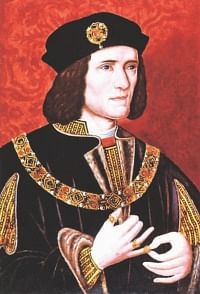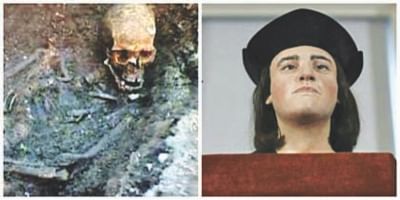| Home - Back Issues - The Team - Contact Us |
 |
| Volume 12 |Issue 07| February 15, 2013 | |
|
|
Straight talk Richard III — The King of Controversy NADIA KABIR BARB
Once upon a time there was a nobleman named Richard. His father was the King of England. Richard was only eight when his father was killed in battle and Richard's brother Edward IV was crowned. When Edward IV died, his son, also named Edward, was to be placed on the throne. Richard the nobleman was made the young prince's protector as the young Edward was only 12 at the time. Edward and his younger brother were both taken to the tower of London for protection before the coronation. However, before he could be crowned king, an act of Parliament declared that young Edward was ineligible to be king as his father had not been legally married to his mother, making both the young princes illegitimate. Thus, Richard the nobleman became the successor to the throne and was crowned King Richard III. Soon after, the stories of how Richard's detractors were summarily executed began to surface. The most scandalous of these was the rumour that the young princes in the tower had been murdered on the orders of their uncle. Certainly, they were never seen alive again in public after Richard's ascension to the throne. Richard III's reign lasted only two years and he was defeated and killed by the first Tudor King, Henry VII, at the Battle of Bosworth. But his reputation as England's most evil and murderous king has lived on for generations. Now, that story sounds like a great basis for a historical novel if you ask me. All you need to do is make the king a hunchback with a twisted arm and you might just have the perfect pantomime villain. But wait a minute, isn't that exactly what Shakespeare did? He took fact and imbued it with a bit of fiction and a hundred years after the death of Richard III, Shakespeare presented a play depicting the king as a ruler who was charismatic and witty but one who murdered and plotted his way to the throne. To make his character more despicable, the bard also gave him a physical deformity with a hunched back and withered arm. Even in his opening soliloquy, Richard describes himself as “...Deformed, unfinish'd, sent before my time; Into this breathing world, scarce half made up, And that so lamely and unfashionable, That dogs bark at me as I halt by them...” Despite his short monarchy from 1483 to 1485, King Richard III is one of the most talked about kings to rule England. Whether it is just Tudor propaganda trying to smear the name of the last of the Plantagenet kings, during his two years in power, it is alleged that Richard III executed those he felt were opposed to him. But Richard lived in an age when murder and intrigue were not out of the ordinary, and many rulers before and after him ascended to the crown in a similar manner. So why he was singled out in his notoriety? His infamy is considered to be so great, that since Richard III, there have been no other King Richards in England. In September 2012 the University of Leicester's archaeology department, spearheaded by the Richard III Society (a society dedicated to reappraising Richard's role in history) announced that they had discovered a skeleton buried in a council car park in Leicester and thought that it was that of Richard III. Unsurprisingly this caused a media buzz and the infamous king came into the spotlight once more. However, it had to be proved that they were the remains of the lost king and for the next few months the nation waited with bated breath for the findings to be publicised. So who was Richard III? Was he really the Machiavellian monster he was made out to be or was he just a product of his feudal era, misrepresented and misunderstood? If the skeleton proved to be Richard III's would his bones speak to us and give us a better understanding of him?
One of the first findings from the discovery of the remains was the person in question undoubtedly had a curvature of the spine and this was identified as scoliosis. This would have made one shoulder much higher than the other and would have caused difficulty in breathing as well as regular discomfort. If the bones belonged to Richard, then he would have had a deformity of the spine but not a hunchback described by Shakespeare. There was also no sign that the arm was withered or distorted. So on the one hand a deformed spine sounded consistent with King Richard, but on the other hand it suggested that Shakespeare might have exaggerated his condition. The first stage was to make sure the skeleton was from the correct time period and experts from Leicester University carried out radio carbon dating on the bones. This confirmed that the remains were from the late 15th or early 16th century, in other words consistent with Richard's death in 1485. I think even Richard III would have been impressed at the thoroughness of the investigation. Two of Richard III's sister's descendants were tracked down (Canadian-born furniture maker Michael Ibsen and a second person who wanted to remain anonymous) and their DNA used to compare with that of the skeletal remains. Dr Turi King, geneticist at the University of Leicester, confirmed that there was a DNA match between the maternal DNA from the family of Richard the Third and the bones found at the car park. The final test was cause of death. It is known that Richard was killed in the Battle of Bosworth during hand to hand combat and accounts written around the time indicate that Richard died from a massive halberd blow to the back of the head. Dr Jo Appleby, an osteo-archaeologist from the university's School of Archaeology and Ancient History, stated that Richard III's skeleton had endured 10 injuries around the time of death, including eight to the skull and two of those wounds were potentially fatal. 'One was a "slice" removing a flap of bone, the other was caused by bladed weapon which went through and hit the opposite side of the skull - a depth of more than 10cm (4ins)'. There were also some 'humiliation injuries' made to his body post-mortem including a pelvic wound likely to have been caused by an upward thrust of a weapon, through the buttock. What the evidence points to is that he was no coward sitting on the sidelines but was in the thick of battle on foot probably having come off his horse and fought for bravely till his death. Richard, as soldier and general in his early career was in fact the last king of England to die fighting on the battlefield. We finally had confirmation that the skeletal remains were truly that of Richard III. What was most fascinating for me was when a team of experts carried out a facial reconstruction of the king using the 3D scans of his skull. What emerged was that the controversial king had a much younger and fuller appearance than the gaunt and crooked images in portraits suggest. Not quite the evil, cold blooded villain you would have expected. In fact, there are no paintings of Richard from the time of his life. The earliest appear about 40 years later and would have been painted during the Tudor times when depicting Richard as wicked and depraved would have found favour with the ruling family. Some historians believe that his portraits were altered after his death to portray him in a harsher light and it has been proven that a hunchback was added to one after the original had been painted. The discovery of Richard III may not have given us all the answers and some mysteries, like the fate of the Princes in the tower may never be solved, but finding Richard's body appears to be prompting a re-evaluation of his role in history and who knows next time you see Richard the III being performed on stage he may not have a hunchback or withered arm.
Copyright
(R) thedailystar.net 2013 |

